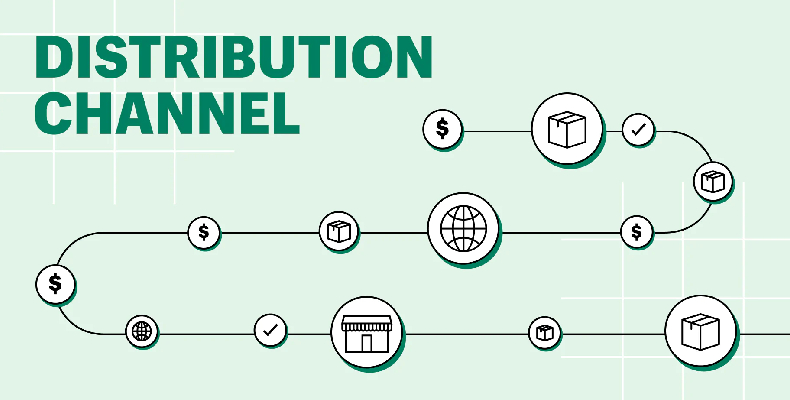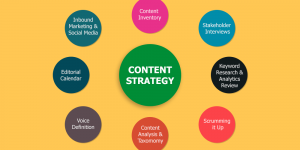
A digital content strategy is a program that summarises content composition, distribution, and management on a web page or digital medium. A digital content strategy aims to drive increased traffic, engagement, and conversions. Here are some steps to create a digital content strategy that drives results. This blog will look into how to create an effective digital content strategy.
What is digital content strategy?
Digital content strategy is creating, publishing, and governing content across a website or digital platform. A digital content strategy aims to cause high traffic, interaction, and lead generation. A digital content strategy includes both short-term tactics and long-term planning, and it should be aligned with an organization’s overall goals.
Developing a digital content strategy involves:
- Understanding the target audience.
- Setting clear goals.
- Conducting a content audit.
- Creating a content calendar.
- Developing a content marketing plan.
- Measuring and analyzing the results.
It is an ongoing process that requires regular review and adjustment to ensure that the content meets the audience’s needs and supports the organization’s goals.
Advantages of digital content strategy
There are several advantages to executing a digital content strategy:
➢ Increased brand awareness:
A well-executed digital content strategy can increase brand awareness by consistently producing and promoting high-quality content that resonates with the target audience.
➢ Improved customer engagement:
Businesses can increase customer engagement and build stronger relationships with their audience by creating and distributing relevant, valuable content.
➢ Increased website traffic:
Consistently producing and promoting high-quality content can drive traffic to a website, possibly directing to improved traffic and sales.
➢ Greater search engine visibility:
A digital content strategy that includes search engine optimization (SEO) can help improve a website’s visibility in search engine results, leading to increased traffic and potential customers.
➢ Enhanced credibility and authority:
By consistently producing and distributing high-quality content, businesses can establish themselves as industry leaders and build credibility and authority in their field.
Overall, a digital content strategy can help businesses to engage effectively and retain customers, increase brand awareness, drive traffic to their website, and achieve their business goals.
Also Read: Chat GPT for Content and SEO
What are the elements of digital content strategy?
There are several critical elements of a digital content strategy:
➢ Goals and objectives:
The first step in developing a digital content strategy is to define the goals and objectives the strategy intends to achieve. This may include expanding brand attention, increasing visitors to a website, generating leads, or increasing sales.

➢ Understanding the audience:
A precise knowledge of the target audience is essential for developing a successful digital content strategy. This includes identifying the audience’s demographics, interests, and needs and the channels and platforms they use to consume content.

➢ Content types and formats:
The next step is determining the types and forms of content used to achieve the defined goals and objectives. This may contain articles, posts to social networks, videos, podcasts, electronic newsletters, and more.
➢ Distribution channels:
The channels and platforms used to distribute the content should be identified, and a plan for how the content will be promoted through each channel should be developed.

➢ Content production and management:
A plan for producing and managing the content should be developed, including the resources and team members needed. This may include creating a content calendar to prepare and organize the creation and dissemination of content.
➢ Metrics and analysis:
To ensure that the digital content strategy is effective, it is essential to establish metrics for measuring the process’s success and regularly analyze the results. This will allow for adjustments to ensure that the strategy remains aligned with the business goals.
Also See: 5 Ways to Future Proof Your Digital Marketing Strategy
Why is digital content important
Digital content is essential because it allows people to access information and entertainment easily and quickly through the internet and other digital platforms. It can be in text, images, videos, audio, and other formats and can be shared and consumed on a wide range of devices, including computers, smartphones, tablets, and smart TVs.
Digital content has become an integral part of our daily lives, and it has the potential to transform the way we learn, communicate, and engage with the world. It can be a powerful tool for education, entertainment, and social connection and can reach a global audience.
Digital content strategy/ steps to create a digital content strategy
Here are some actions you can follow to make a digital content strategy:
➢ Determine your objectives:
Your goals include increasing label attention, moving traffic to your internet site, generating leads, or boosting sales.
➢ Recognize your select audience:
Who do you like to acquire with your digital content? Consider age, gender, location, likes, and conducts.
➢ Determine your brand voice and style:
How do you like your label to reach your audience? Your brand voice and type should be consistent across your digital content.
➢ Conduct a content audit:
Review all the digital content you currently have, including your internet site, web blog, social networking sites, etc. Recognize what’s performing nicely and what requires betterment.
➢ Create a distribution plan:
Decide how to share your digital content with your target audience. This might include social media, email marketing, paid advertising, and other tactics.
➢ Measure and analyze your results:
Use tools like Google Analytics to track the performance of your digital content and see how it contributes to your business goals. Use this data to refine your strategy and improve your results.
Digital content strategies for specific content types
The exact steps for creating a digital content strategy will depend on the types of content that you are making. However, here are some general considerations for a few common types of content:
1. Blog posts:
Identify the issues that will be published in your blogs.
Choose the regularity at which you will post blogs.
Identify the target audience for your blog and the channels you will use to promote your posts (e.g. social media, email newsletters).

Develop a plan for producing and managing your blog content, including assigning roles to team members and establishing a content calendar.
Establish metrics for measuring the success of your blogs, such as traffic and engagement, and regularly analyze the results to identify areas for improvement.
2. Social media posts:
Identify the social media platforms that you will use to share your content.
Determine the frequency and types of content you will publish on your media.
Develop a plan for producing and managing your social media content, including assigning roles to team members and establishing a content calendar.

Establish metrics for measuring the success of your social media content, such as likes, comments, and shares, and regularly analyze the results to identify areas for improvement.
3. Videos:
Identify the topics and formats that will be covered in your videos.
Select the regularity at which you will post the latest videos.
Identify the target audience for your videos and the channels you will use to promote them (e.g. YouTube, social media).
Develop a plan for producing and managing your video content, including assigning roles to team members and establishing a content calendar.
Establish metrics for measuring the success of your videos, such as views and engagement, and regularly analyze the results to identify areas for improvement.
Overall, the key to developing a successful digital content strategy for any content type is to define your goals and target audience clearly and to regularly review and adjust your strategy as needed to ensure that it remains effective.
FAQs
1. What is a digital content strategy?
A digital content strategy creates and distributes applicable, appropriate, and constant content to draw and keep a distinctly depicted audience and achieve specific business goals.
2. Why is a digital content strategy important?
A digital content strategy helps you to focus on your business goals and target audience and to create and distribute content that is compatible with both. It also allows you to measure the effectiveness of your content and make data-driven decisions about how to improve it.
3. How do you design a digital content strategy?
To design a digital content strategy, you should define your goals, recognize your target audience, specify your brand voice and tone, conduct a content audit, create a content calendar, create a distribution plan, and calculate and study your results.
4. What are some examples of digital content?
Examples of digital content include website pages, blog posts, social media posts, ebooks, podcasts, videos, and email newsletters.
5. How do you gauge the progress of a digital content strategy?
You can measure the progress of a digital content strategy by tracking key performance indicators (KPIs) such as website traffic, engagement rates, leads generated, and sales. You can utilize instruments like Google Analytics to help you track and analyze these metrics.
Conclusion
Creating a digital content strategy is crucial in driving results on a website or digital platform. A well-thought-out digital content strategy helps organizations define their target audience, set clear goals, produce relevant and high-quality content, and promote it effectively.
To create a digital content strategy that drives results, it is essential to conduct a content audit, create a content calendar, develop a content marketing plan, and regularly measure and analyze the performance of the content. By following these steps and continuously adjusting the strategy based on data and feedback, organizations can create a successful digital content strategy that supports their business goals and resonates with their audience. We hope this article on ”how to create an effective digital content strategy” is useful to the readers.






